‘The Outer Worlds’ Tells Good Stories But Gives You Dull Adventures
Credit to Author: Rob Zacny| Date: Fri, 25 Oct 2019 20:49:40 +0000
The Outer Worlds begins poorly, and ends well. In fact its entire structure is one of nested narratives that follow this progression from awkward starts to rewarding and complicated finishes. But the entire experience of the game is contained within the microcosm of its starting area. There were all the irritations that frequently turned it into a slog, and then there were the endings and the grace notes that kept me going.
My first three hours with the game perfectly encapsulated the roughly 30 hours I ended up spending with it (in a fairly leisurely and inefficient playthrough that still left a few major sideplots unresolved). In general its characters and humor that are as overstated as the hyper-saturated flora and fauna that populate its world. Its Gilded Age- Firefly shtick wore thin through repetition, and doing quests often involved one forgettable massacre after another.
Then I started really getting to know some of the major characters in the small town of Edgewater, a rusting company town built around a deadly fish cannery that no longer receives any fish, with a workforce slowly dying of sickness and exhaustion. As I paid off the major quest lines. I realized that Outer Worlds had successfully painted a picture of a community and the lives people led there, albeit with clumsy brushstrokes. I understood that even as Edgewater was an undeniable hellhole, it was still home to people. I found traces of an ashamed conscience in the worst of its corporate lackeys, while the leader of a worker’s collective had a utopian vision marred by a persistent, disquieting vindictiveness.
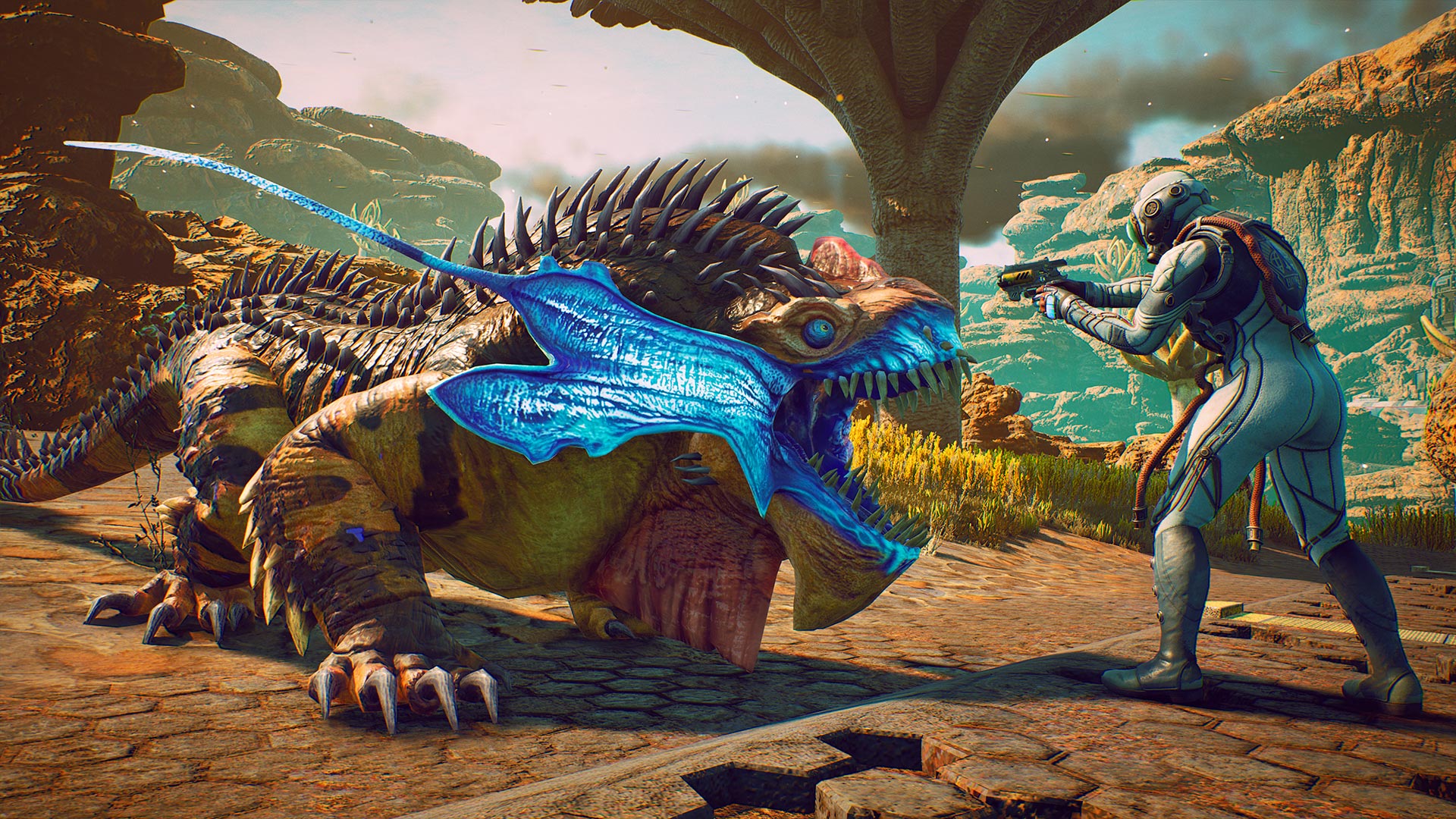
Now, as you always must in a game from Obsidian, it was time to make some choices that would profoundly affect that community, and hurt some of the people in it. The choice was straightforward but the consequences were not, and I felt anything but heroic when I saw the immediate impact of what I’d done. I had effectively destroyed Edgewater using information and tools given to me in good faith. My own companion, a nerdy engineer named Parvati (who is basically an asexual version of the character Kaylee from Firefly) had begged me not to do it. Then I had to go back, face what I’d done and the people I’d done it to. Finally, I took what I came for, and left everyone in Edgewater behind to an uncertain fate.
The Outer Worlds nails those big moments, intertwining personal stakes with broader philosophical or social themes. They come to life via some sharp character work and a lot of stage-setting, and they often include a satisfying amount of ambiguity in their resolution to keep the story more complicated and convincing than didactic. But just as the high-point of that prologue hinted at the best that was to come, the dull path that led me there revealed the worst.
The Outer Worlds introduces you to its world via the act of character creation, as rogue corporate dissident Phineas Welles sneaks aboard an antique colony ship that went missing decades ago en route to the Halcyon system, where the action takes place. The lost ship’s name is Hope, underscoring once again the broad brush with which this game paints. With a ship full of hundreds of colonists trapped in cryogenic storage, the character you create provides him with just the subject he’s looking for.
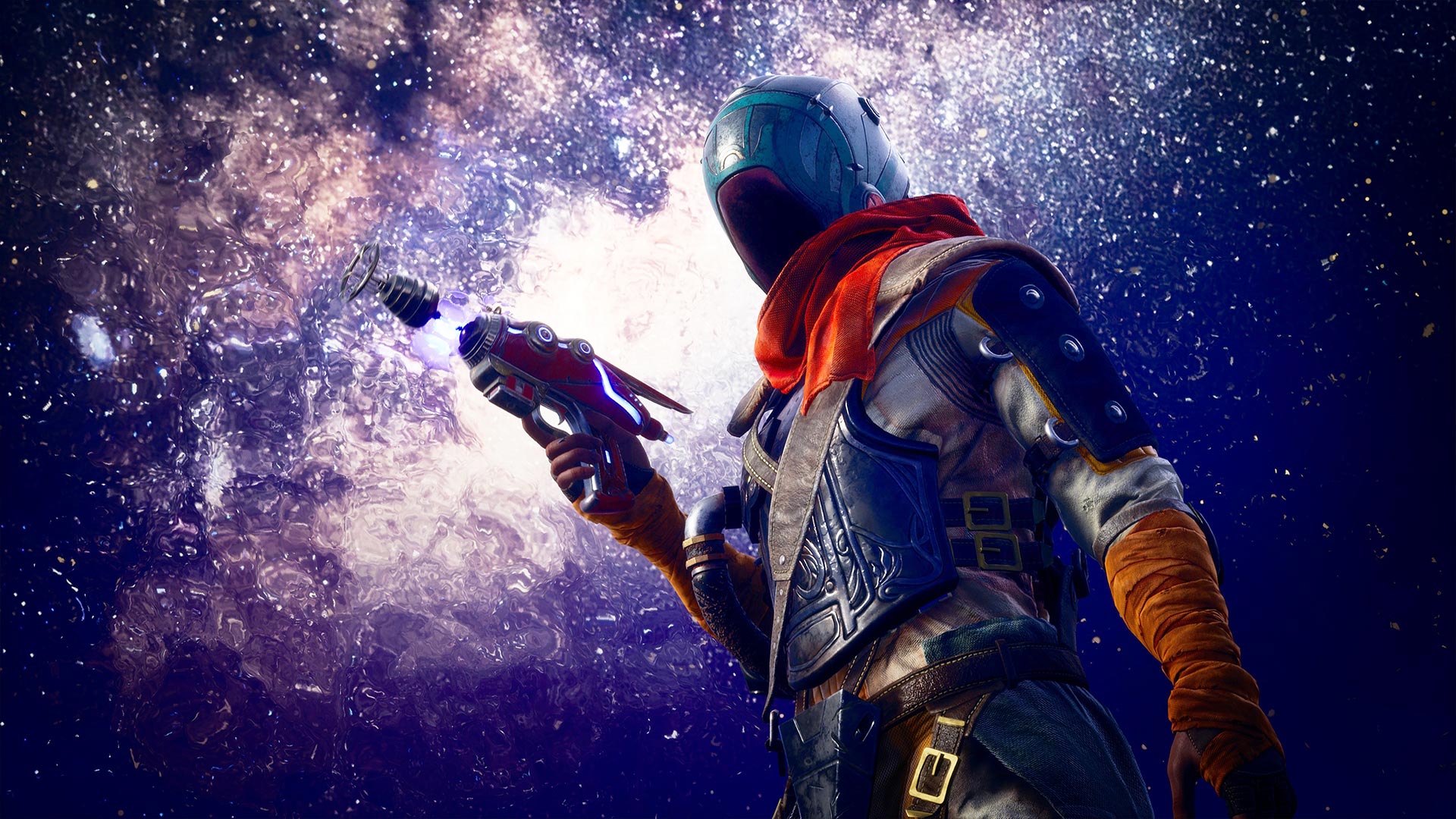
The character creator is surprisingly flexible in some areas (as Austin noted regarding its options for black hair styles), but significantly less so in others. It becomes more obvious as you play, and meet planets full of similar-looking wasp-waisted people. It also commits the misstep of requiring the player select a male or female character, despite a plethora of options that allow you to customize how your character presents. With obvious thought being given to making those options available, it seems like it would have been a short walk to do something like the choice of pronoun that Battletech’s character creator gives players. That said, you’ll also find gender stereotypes don’t weigh too heavily in The Outer Worlds, whose general aesthetic for characters is “Ziggy Stardust plays Oliver Twist.”
In the decades since Hope was lost, the Halcyon system has become a patchwork of corporate fiefs answering to a central Board that governs affairs for the good of its corporate stakeholders. What this means in practice is that each location you visit is effectively a comic-dystopian company town, where security guards double as police, executives as governors, and employees as indentured laborers. Phineas wants your help to save the colonists still trapped aboard the Hope, and strike a blow against the Board in the process. This launches you on a long “chain of favors” style story through Halcyon, as you and your new shipmates aboard the Unreliable (basically a copy of the Serenity set) go from place to place gathering the information and equipment needed to help the Hope colonists. Each new setting has its part to play in the grander story, but it also features its own series of dramas and conflicts whose resolutions function as chapters within the game.
The problem with this setting and its specific locations is that everything feels like an elaborate and not particularly inspired comedy bit. Characters repeat corporate sales pitches and slogans so reflexively that the premise’s goofy charm wears thin quickly. In having so many of its major characters be part of the joke in Outer Worlds, they often become jokes themselves and it’s therefore harder to identify with or care about the struggles and dilemmas that each quest line resolves. One character you meet is trapped in a corporate mascot’s uniform and sends out desperate requests for aid, but resolutely parrots corporate pablum at you when you attempt to help. It’s an extensive dialogue tree, with something like a half-dozen variations on, “I appreciate that you want to help me, but you know what really helps is Spacer’s Choice Discount Medicine, now with fewer toxins!”
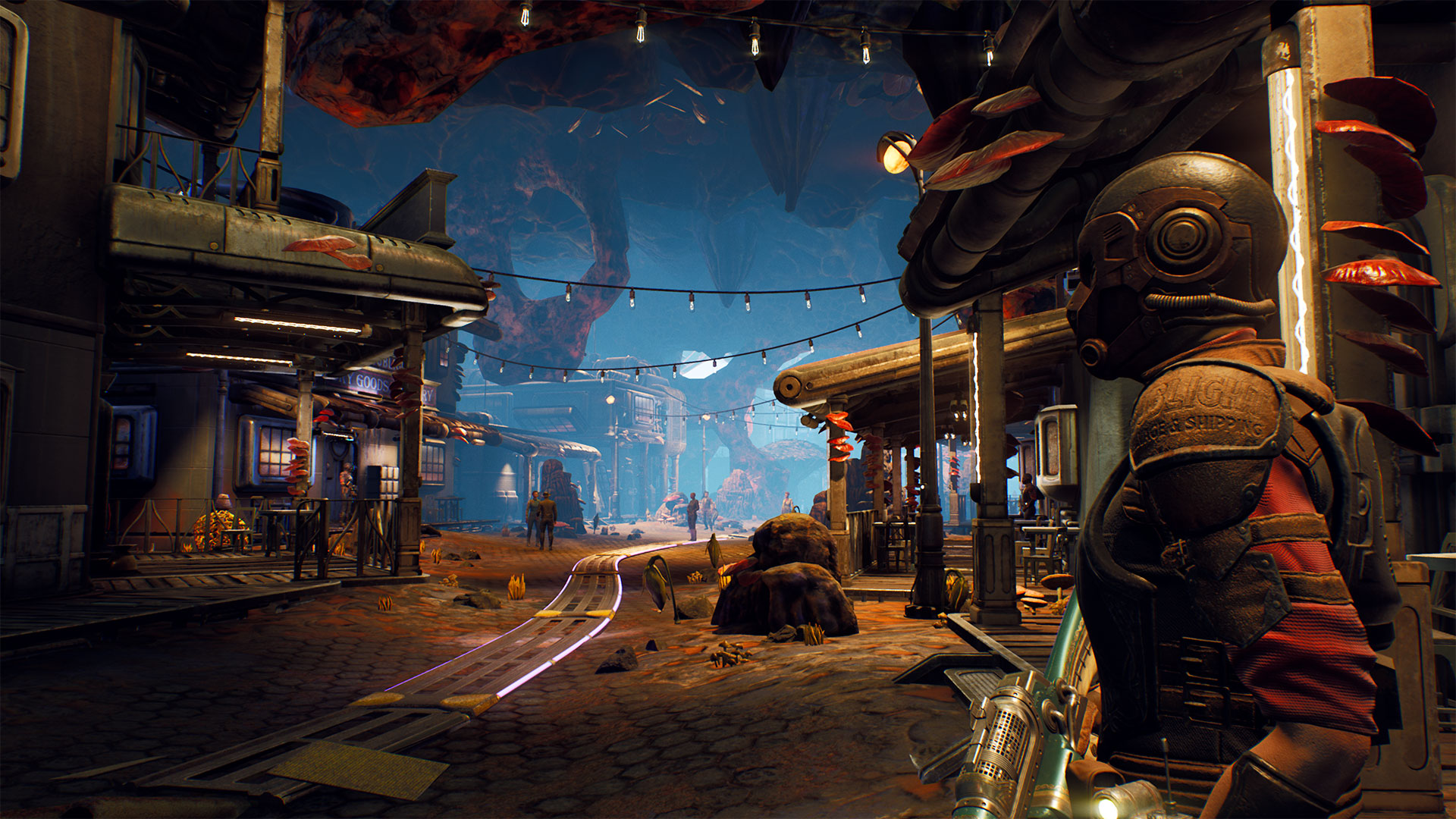
Not every character does this, but a number are also throwaway characters with just one animating impulse. There’s “the prejudiced, overbearing mother looking for her runaway son” or “the nerd girl who wants to be a pirate queen.”. Their two-dimensional nature, reinforced through repetitive dialogue trees, portrays them as irremediable dumbasses whose sole function is to give you a bad errand with a bag of experience points at the end.
What’s often missing here is an awareness of the sickness of the world and society they are trapped in. Most RPGs suffer from some version of this problem: In order to give the player agency and impact on the world, player characters often come across as the sole bearer of common sense in a world full of people who are completely bewildered at straightforward conflicts and challenges. But there is also a rich tradition of dystopian or dark comedy where characters simultaneously recognize the absurdity of their circumstances and even their own actions, but are compelled to go along, like Stoppard’s version of Rosencrantz and Guildenstern, to a dismal conclusion. Characters in an absurdist story need not always be absurd themselves, but that is too often the tack that Outer Worlds takes.
This motif is especially frustrating in a game satirizing the relationship between workers, managers, and the capitalists that rule them both. The Outer Worlds deploys the aesthetics and economic relationships of the Gilded Age and the first Industrial Revolution, but strips out the burgeoning class awareness that typified that period. Now admittedly, The Outer Worlds is using the mask-off avarice of corporate management in that period to tell a story about class relations in an era when most of us have been conditioned to think in reflexively individualist terms. The naked exploitation and hollow bromides we see in The Outer Worlds serve an illustrative purpose to throw some of our own era into sharp relief, but the satire is so broad that it also alienated me from it.
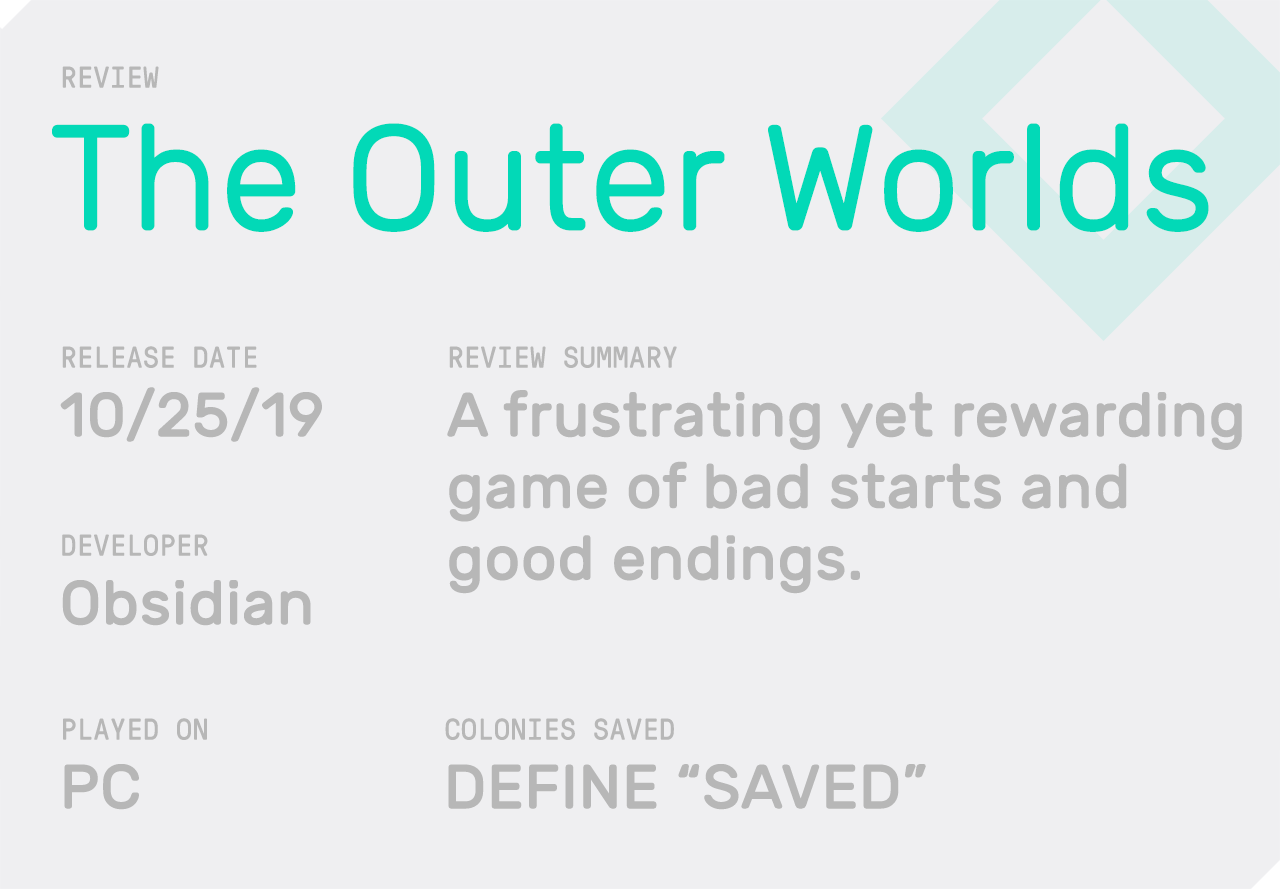
Which may be the point. Games are entertainment products and so, while being topical has a value, being overtly political comes with more possible downsides. The Outer Worlds portrays corporate malfeasance and exploitation of workers, but its setting is so heightened that you can as easily reject it as an allegory for late capitalism. So many of these workers are just accepting of their lot, so unable to see the forest for the trees, that Horatio Alger could be as helpful to them as Marx. If you want to see The Outer Worlds as a paean to individualism, there is little in its text that could challenge that interpretation. Business isn’t the enemy in The Outer Worlds, just bad business.
Here again, however, The Outer Worlds manages to complicate this with a strong ending. Without giving too much away, there is also a looming ecological catastrophe facing Halcyon and the way the game frames your actions and decisions against that reality is surprising. While everything else in the game might suggest that a single smart person just needs to show up and confront these broken systems, the finale is considerably more ambiguous about whether all those good individual actions will add up to something that answers the scale of the crisis.
The Outer Worlds lives and dies by its theme and narrative because as an RPG system, it’s not terribly interesting. It allows the usual stealth-combat-dialogue paths through each quest, but in the most conventional and uninteresting way. If there front door of a key location is guarded, there’s almost certainly an easy-to-find back door with a lockpicking skill-check required to get through it. In a lot of locations, there also tend to be characters who you can convince to let you pass without firing a short. Combat features VATS-like bullet-time system, but also like modern Fallout games, it is more a convenience than a necessity. Statistically my character was garbage with a gun, but that only really affected damage numbers and critical chances. At no point was I discouraged from standing in front of an enemy and blasting away, and with all my stats in leadership and charisma, my companion characters received bonuses to deal devastating strikes with their unique-abilities practically at-will.
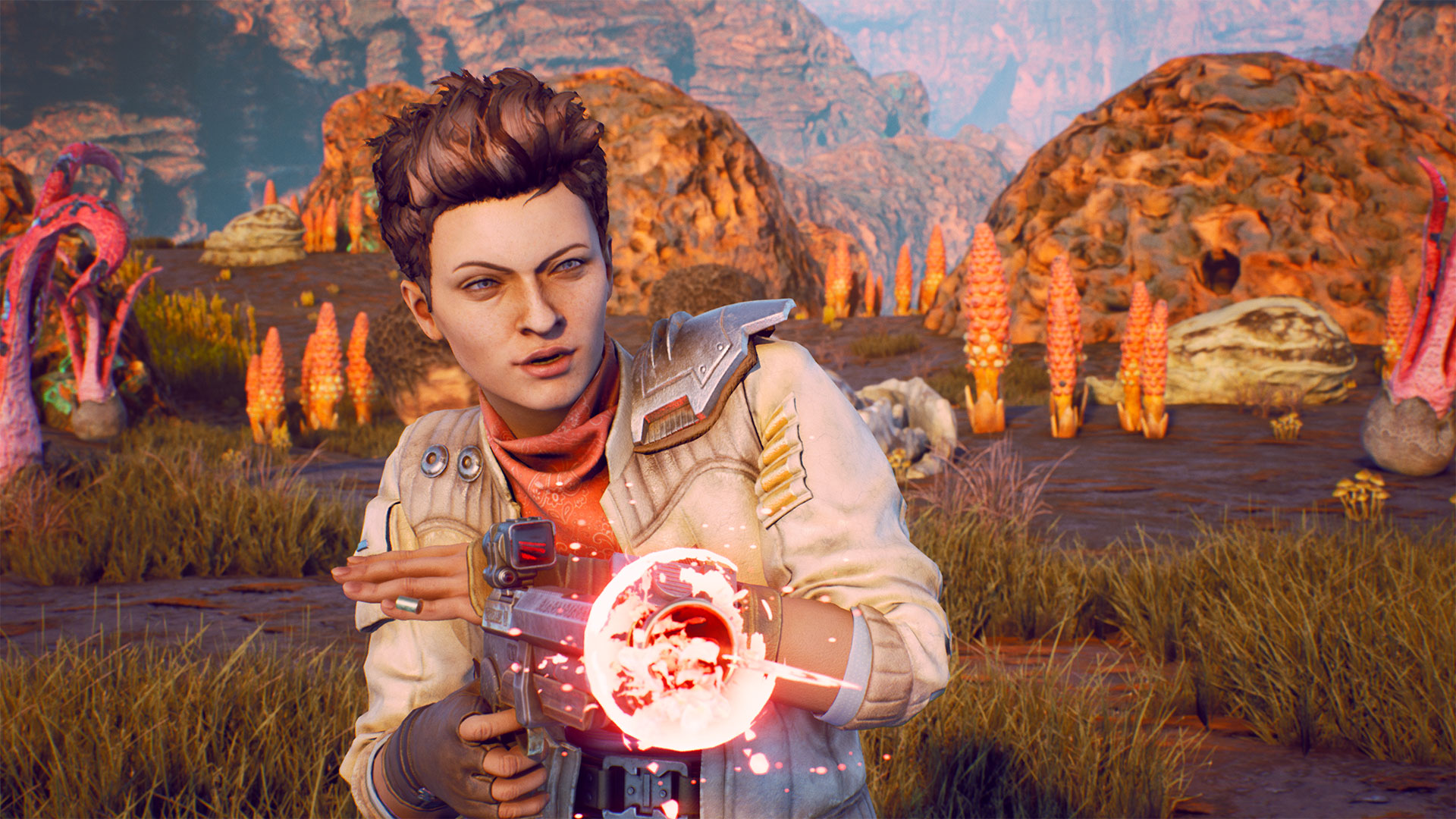
At the very least, this ensures that combat can be dispensed-with quickly, but if that’s the virtue of this system, then its vice is how large a role combat still plays. Admittedly most of the major quest lines increasingly become dialogue and exploration-driven, but that only highlights how meaningless many of The Outer Worlds’ most developed systems are. There is a really involved healing-buff system that basically never matters thanks to how quickly hitpoints regenerate, and how easy combat is. Maybe all of that matters more in the “survival mode” where you have to eat and sleep, but I was frankly not interested in finding out.
The Outer Worlds is only sometimes the best version of itself. When it takes its characters humanity seriously and finds actual emotions and beliefs to put in their mouths, good voice acting and character design bring them to a life that is as vibrant as any you’ll find in an RPG. The superb musical score casts its spell over a location that briefly feels like a real place, with a past and present readable in its architecture and signage, and the signs of wear and tear that attend just about everything in this setting.
Those moments pass, though, and return you to a static world of caricatures and comic dioramas, a kingdom of the willfully blind waiting for you to tell them what you see, and what it’s supposed to mean.
This article originally appeared on VICE US.